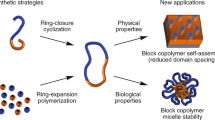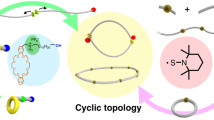Abstract
Cyclic polymers have dramatically different physical properties compared with those of their equivalent linear counterparts. However, the exploration of cyclic polymers is limited because of the inherent challenges associated with their synthesis. Conjugated linear polyacetylenes are important materials for electrical conductivity, paramagnetic susceptibility, optical nonlinearity, photoconductivity, gas permeability, liquid crystallinity and chain helicity. However, their cyclic analogues are unknown, and therefore the ability to examine how a cyclic topology influences their properties is currently not possible. We have solved this challenge and now report a tungsten catalyst supported by a tetraanionic pincer ligand that can rapidly polymerize alkynes to form conjugated macrocycles in high yield. The catalyst works by tethering the ends of the polymer to the metal centre to overcome the inherent entropic penalty of cyclization. Gel-permeation chromatography, dynamic and static light scattering, viscometry and chemical tests are all consistent with theoretical predictions and provide unambiguous confirmation of a cyclic topology. Access to a wide variety of new cyclic polymers is now possible by simply choosing the appropriate alkyne monomer.
This is a preview of subscription content, access via your institution
Access options
Subscribe to this journal
Receive 12 print issues and online access
$259.00 per year
only $21.58 per issue
Buy this article
- Purchase on Springer Link
- Instant access to full article PDF
Prices may be subject to local taxes which are calculated during checkout







Similar content being viewed by others
References
Jia, Z. & Monteiro, M. J. Cyclic polymers: methods and strategies. J. Polym. Sci. A 50, 2085–2097 (2012).
Tezuka, Y. Topological Polymer Chemistry: Progress of Cyclic Polymers in Syntheses, Properties and Functions (World Scientific Publishing Company, 2012).
Garcia Bernal, J. M., Tirado, M. M., Freire, J. J. & Garcia de la Torre, J. Monte Carlo calculation of hydrodynamic properties of linear and cyclic polymers in good solvents. Macromolecules 24, 593–598 (1991).
Orrah, D. J., Semlyen, J. A. & Ross-Murphy, S. B. Studies of cyclic and linear poly(dimethylsiloxanes): 28. Viscosities and densities of ring and chain poly(dimethylsiloxane) blends. Polymer 29, 1455–1458 (1988).
Bannister, D. J. & Semlyen, J. A. Studies of cyclic and linear poly(dimethyl siloxanes): 6. Effect of heat. Polymer 22, 377–381 (1981).
Clarson, S. J., Dodgson, K. & Semlyen, J. A. Studies of cyclic and linear poly(dimethylsiloxanes): 19. Glass-transition temperatures and crystallization behavior. Polymer 26, 930–934 (1985).
Griffiths, P. C., Stilbs, P., Yu, G. E. & Booth, C. Role of molecular architecture in polymer diffusion: a PGSE–NMR study of linear and cyclic poly(ethylene oxide). J. Phys. Chem. 99, 16752–16756 (1995).
Santangelo, P. G., Roland, C. M., Chang, T., Cho, D. & Roovers, J. Dynamics near the glass temperature of low molecular weight cyclic polystyrene. Macromolecules 34, 9002–9005 (2001).
Patel, A., Cosgrove, T. & Semlyen, J. A. Studies of cyclic and linear poly(dimethylsiloxanes): 30. Adsorption studies on silica in solution. Polymer 32, 1313–1317 (1991).
Flory, P. J. & Semlyen, J. A. Macrocyclization equilibrium constants and the statistical configuration of poly(dimethylsiloxane) chains. J. Am. Chem. Soc. 88, 3209–3212 (1966).
Pasini, D. The click reaction as an efficient tool for the construction of macrocyclic structures. Molecules 18, 9512–9530 (2013).
Pangilinan, K. & Advincula, R. Cyclic polymers and catenanes by atom transfer radical polymerization (ATRP). Polym. Int. 63, 803–813 (2014).
Kricheldorf, H. R. Cyclic polymers: synthetic strategies and physical properties. J. Polym. Sci. A 48, 251–284 (2010).
Kapnistos, M. et al. Unexpected power-law stress relaxation of entangled ring polymers. Nature Mater. 7, 997–1002 (2008).
Laurent, B. A. & Grayson, S. M. Synthetic approaches for the preparation of cyclic polymers. Chem. Soc. Rev. 2009, 2202–2213 (2009).
Ishizu, K. K. H. Novel synthesis and characterization of cyclic polystyrenes. Polymer 37, 1487–1492 (1996).
Hoskins, J. N. & Grayson, S. M. Cyclic polyesters: synthetic approaches and potential applications. Polym. Chem. 2, 289–299 (2011).
Shin, E. J. et al. Crystallization of cyclic polymers: synthesis and crystallization behavior of high molecular weight cyclic poly(ε-caprolactone)s. Macromolecules 44, 2773–2779 (2011).
Hans, R. & Kricheldorf, S.-R. L. Polylactones. 35. Macrocyclic and stereoselective polymerization of β-D,L-butyrolactone with cyclic dibutyltin initiators. Macromolecules 28, 6718–6725 (1995).
Brown, H. A. & Waymouth, R. M. Zwitterionic ring-opening polymerization for the synthesis of high molecular weight cyclic polymers. Acc. Chem. Res. 46, 2585–2596 (2013).
Brown, H. A., Chang, Y. A. & Waymouth, R. M. Zwitterionic polymerization to generate high molecular weight cyclic poly(carbosiloxane)s. J. Am. Chem. Soc. 135, 18738–18741 (2013).
Asenjo-Sanz, I., Veloso, A., Miranda, J. I., Pomposo, J. A. & Barroso-Bujans, F. Zwitterionic polymerization of glycidyl monomers to cyclic polyethers with B(C6F5)3 . Polym. Chem. 5, 6905–6908 (2014).
Bielawski, C. W., Benitez, D. & Grubbs, R. H. An ‘endless’ route to cyclic polymers. Science 297, 2041–2044 (2002).
Xia, Y. et al. Ring-expansion metathesis polymerization: catalyst-dependent polymerization profiles. J. Am. Chem. Soc. 131, 2670–2677 (2009).
Kricheldorf, H. R., Stricker, A. & Gomurashvili, Z. Polymers of carbonic acid, 30 ring-expansion polymerization of trimethylene carbonate (TMC, 1,3-dioxanone-2) with dibutyltin succinate or adipate. Macromol. Chem. Phys. 202, 413–420 (2001).
Bielawski, C. W., Benitez, D. & Grubbs, R. H. Synthesis of cyclic polybutadiene via ring-opening metathesis polymerization: the importance of removing trace linear contaminants. J. Am. Chem. Soc. 125, 8424–8425 (2003).
Nakao, K. et al. Giant macrocycles composed of thiophene, acetylene, and ethylene building blocks. J. Am. Chem. Soc. 128, 16740–16747 (2006).
Dutta, T. et al. Synthesis and self-assembly of triphenylene-containing conjugated macrocycles. RSC Adv. 3, 6008–6015 (2013).
Iyoda, M., Yamakawa, J. & Rahman, M. J. Conjugated macrocycles: concepts and applications. Angew. Chem. Int. Ed. 50, 10522–10553 (2011).
Semlyen, J. A. Cyclic Polymers 2nd edn (Kluwer Academic Publishers, 2000).
O'Reilly, M. E. & Veige, A. S. Trianionic pincer and pincer-type metal complexes and catalysts. Chem. Soc. Rev. 2014, 6325–6369 (2014).
McGowan, K. P., O'Reilly, M. E., Ghiviriga, I., Abboud, K. A. & Veige, A. S. Compelling mechanistic data and identification of the active species in tungsten-catalyzed alkyne polymerizations: conversion of a trianionic pincer into a new tetraanionic pincer-type ligand. Chem. Sci. 2013, 1145–1155 (2013).
Kuppuswamy, S., Peloquin, A. J., Ghiviriga, I., Abboud, K. A. & Veige, A. S. Synthesis and characterization of tungsten(VI) alkylidene complexes supported by an [OCO]3− trianionic pincer ligand: progress towards the [tBuOCO]W≡CC(CH3)3 fragment. Organometallics 29, 4227–4233 (2010).
Boydston, A. J., Xia, Y., Kornfield, J. A., Gorodetskaya, I. A. & Grubbs, R. H. Cyclic ruthenium–alkylidene catalysts for ring-expansion metathesis polymerization. J. Am. Chem. Soc. 130, 12775–12782 (2008).
Zimm, B. H. & Stockmayer, W. H. The dimensions of chain molecules containing branches and rings. J. Chem. Phys. 17, 1301–1314 (1949).
Mastrorilli, P. et al. Polymerization of phenylacetylene and of p-tolylacetylene catalyzed by β-dioxygenatorhodium(I) complexes in homogeneous and heterogeneous phase. J. Mol. Catal. 178, 35–42 (2002).
Trhlíková, O., Zedník, J., Balcar, H., Brus, J. & Sedláček, J. [Rh(cycloolefin)(acac)] complexes as catalysts of polymerization of aryl- and alkylacetylenes: influence of cycloolefin ligand and reaction conditions. J. Mol. Catal. A 378, 57–66 (2013).
Roovers, J. Dilute-solution properties of ring polystyrenes. J. Polym. Sci. B 23, 1117–1126 (1985).
Benmouna, M. & Maschke, U. in Cyclic Polymers (ed. Semlyen, J. A.) 781–782 (Kluwer Academic Publishers, 2000).
Hoskins, J. N. & Grayson, S. M. Synthesis and degradation behavior of cyclic poly(ε-caprolactone). Macromolecules 42, 6406–6413 (2009).
Acknowledgements
A.S.V. thanks the University of Florida (UF) for financial support of this project. This material is based on work supported by the National Science Foundation (NSF) CHE-1265993. K.A.A. thanks the UF and the NSF CHE-0821346 for funding the purchase of X-ray equipment. The authors thank B. S. Tucker and C. P. Kabb for their assistance with GPC characterization, and M. R. Hill for assistance in acquiring DLS data. B. S. Sumerlin is thanked for insightful discussions.
Author information
Authors and Affiliations
Contributions
C.D.R. synthesized and characterized catalyst 4 and all the cyclic polyenes. C.D.R. co-wrote the paper. H.L. hydrogenated the polymers, characterized the hydrogenated the polymers and executed the ozonolysis reactions. H.L. edited the paper. K.A.A. performed single-crystal X-ray experiments and solved the solid-state structure for complex 4. K.B.W. analysed the polymer characterization data, and edited the paper. A.S.V. conceived the experiments, analysed the characterization data and co-wrote the paper.
Corresponding author
Ethics declarations
Competing interests
The authors declare no competing financial interests.
Supplementary information
Supplementary information
Supplementary information (PDF 1424 kb)
Supplementary information
Crystallographic data for compound 4. (CIF 1150 kb)
Rights and permissions
About this article
Cite this article
Roland, C., Li, H., Abboud, K. et al. Cyclic polymers from alkynes. Nature Chem 8, 791–796 (2016). https://doi.org/10.1038/nchem.2516
Received:
Accepted:
Published:
Issue Date:
DOI: https://doi.org/10.1038/nchem.2516
This article is cited by
-
Recyclable cyclic bio-based acrylic polymer via pairwise monomer enchainment by a trifunctional Lewis pair
Nature Chemistry (2023)
-
Scalable and continuous access to pure cyclic polymers enabled by ‘quarantined’ heterogeneous catalysts
Nature Chemistry (2022)
-
Ring contraction of metallacyclobutadiene to metallacyclopropene driven by π- and σ-aromaticity relay
Nature Synthesis (2022)
-
Scalable preparation and direct visualization of cyclic polymers via self-folding cyclization technique
Science China Chemistry (2022)



